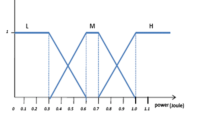Abstract
In this paper, a routing protocol which utilizes the characteristics of Bluetooth technology is proposed for Bluetooth-based mobile ad hoc networks. The routing tables are maintained in the master devices and the routing zone radius for each table is adjusted dynamically by using evolving fuzzy neural networks. Observing there exists some useless routing packets which are helpless to build the routing path and increase the network loads in the existing ad hoc routing protocols, we selectively use multiple unicasts or one broadcast when the destination device is out of the routing zone radius coverage of the routing table. The simulation results show that the dynamic adjustment of the routing table size in each master device results in much less reply time of routing request, fewer request packets and useless packets compared with two representative protocols, Zone Routing Protocol and Dynamic Source Routing.
Similar content being viewed by others
REFERENCES
A. Das, A. Ghose, A. Razdan, H. Saran, and R. Shorey, Enhancing performance of asynchronous data tra. c over the Bluetooth wireless ad-hoc network, INFOCOM 2001, Vol. 1 pp. 591–600, 2001.
P. Johansson, M. Kazantzidis, R. Kapoor, and M. Gerla, Bluetooth:an enabler for personal area networking, IEEE Network, vol. 15, No. 5, pp. 28–37, 2001.
D. Groten and J. R. Schmidt, Bluetooth-based mobile ad hoc networks:opportunities and challenges for a telecommu-nications operator, IEEE Vehicular Technology Conference, 2001, Vol. 2, pp. 1134–1138, 2001.
B. A. Miller and C. Bisdikian, Bluetooth Revealed, Prentice-Hall, Inc., Englewood cli. s, NJ, 2001.
E. Royer and C.-K. Toh, A review of current routing proto-cols for ad hoc mobile wireless networks, IEEE Personal Communications, pp. 46–55, 1999.
D. B. Johnson and D. A. Maltz, Dynamic source routing in ad-hoc wireless networks, in:Mobile Computing, T. Imielinski and H. Korth (Eds. ), Kluwer, Dordrecht, pp. 153–81, 1996.
Z. J. Haas and M. R. Pearlman, The performance of query control schemes for the Zone Routing Protocol, IEEE Trans-actions on Networking, Vol. 9, No. 4, pp. 427–438, 2001.
M. R. Pearlman, Z. J. Haas and S. I. Mir, Using routing zones to support route maintenance in ad hoc networks, IEEE 2000 Wireless Communications and Networking Confer-ence, Vol. 3, pp. 1280–1285, 2000.
B. J. Prabhu, and A. Chockalingam, A routing protocol and energy e. cient techniques in Bluetooth scatternets, 2002 IEEE International Conference on Communications, Vol. 5, pp. 3336–3340, 2002.
N. K. Kasabov and Q. Song. DENFIS:dynamic evolving neural-fuzzy inference system and its application for time-ser-ies prediction, IEEE Transactions on Fuzzy Systems, Vol. 10, No. 2, pp. 144–154, 2002.
G. Sorwar, A. Abraham, and L. S. Dooley, Texture classi-cation based on DCT and soft computing, The 10th IEEE International Conference on Fuzzy Systems, Vol. 3, pp. 545–548, 2001.
N. Kasabov and G. Iliev, Hybrid system for robust recognition of noisy speech based on evolving fuzzy neural networks and adaptive ltering, The IEEE-INNS-ENNS International Joint Conference on Neural Networks, Vol. 5, pp. 91–96, 2000.
N. Kasabov, S. Israel, and B. J. Woodford, Hybrid evolving con-nectionist systems for image classi cation, Journal of Advanced Computational Intelligence, Vol. 4, No. 1, pp. 57–65, 2000.
B. J. Woodford and N. K. Kasabov, Ensembles of EFuNNs: an architecture for a multimodule classi er, The 10th IEEE International Conference on Fuzzy Systems, Vol. 3, pp. 1573–1576, 2001.
Futschik, E. Matthias, A. Reeve, and N. Kasabov, Evolving connectionist systems for knowledge discovery from gene expression data of cancer tissue, Arti cial Intelligence in Med-icine, Vol. 28, No. 2, pp. 165–89, 2003.
N. Kasabov, Evolving fuzzy neural networks for supervised/ unsupervised on-line knowledge-based learning, IEEE Trans-actions on Systems, Man and Cybernetics, Part B:Cybernet-ics, vol. 31, no. 6, pp. 902–918, 2001.
Y. F. Wong, and W. C. Wong, A fuzzy-decision-based rout-ing protocol for mobile ad hoc networks, 10th IEEE Interna-tional Conference on Network, pp. 317–322, 2002.
G. V. S. Raju, G. Hernandez, and Q. Zou, Quality of service routing in ad hoc networks, 2000 IEEE Wireless Communica-tions and Networking Conference, Vol. 1, pp. 263–265, 2000.
Q. Liang, Soft handover for nonuniformly-loaded mobile multimedia cellular networks, 55th IEEE Vehicular Technol-ogy Conference, Vol. 3, pp. 1096–1100, 2002.
A Rodriguez-Vazquez, R. Navas, M. Delgado-Restituto, and F. Vidal-Verdu, A modular programmable CMOS analog fuzzy controller chip, IEEE Trans. Circuits and Systems II: Analog and Digital Signal Processing, Vol. 46, No. 3, pp. 251–265, 1999.
K. Daijin, An implementation of fuzzy logic controller on the recon gurable FPGA system, IEEE Transactions on Industrial Electronics, Vol. 47, No. 3, pp. 703–715, 2000.
M. N. Uddin, T. S. Radwan and M. A. Rahman, Perfor-mances of fuzzy-logic-based indirect vector control for induc-tion motor drive, IEEE Transactions on Industry Applications, Vol. 38, No. 5, pp. 1219–1225, 2002.
W. Pedrycz and F. Gomide, An introduction to fuzzy sets: analysis and design (complex adaptive systems), MIT Press, Cambridge, MA, 1998.
J. J. Buckley, E. Eslami, and E. Esfandiar, An introduction to fuzzy logic and fuzzy sets (advances in soft computing), Physica Verlag, 2002.
M. R. Pearlman, and Z. J. Haas, Determining the optimal con guration for the Zone Routing Protocol, IEEE Journal on Selected Areas in Communications Vol. 17, No. 8, pp. 1395–1414, 1999.
A. Abraham, Neural fuzzy systems:state-of-the-art modeling techniques, in:Connectionist Models of Neurons, Learning Processes, and Arti cial Intelligence, Jose Mira and Alberto Prieto (Eds. ), Springer-Verlag, Germany, ISBN 3–540-42235-8, Granada, Spain, pp. 269-276, June 2001.
A. Abraham and B. Nath, Designing optimal neuro-fuzzy architectures for intelligent control, 6th International Confer-ence on Control, Automation, Robotics and Vision, (CD ROM Proceeding), ISBN 981 0434456, Singapore, December 2000.
J. Principe, N. Euliano, and W. Lefebvre, Neural and adap-tive systems:fundamentals through simulations, John Wiley & Sons, Inc., New York, 2000.
P. Bhagwat and A. Segal, A Routing Vector Method (RVM) for routing in Bluetooth scatternets, 1999 Mobile Multimedia Communications, pp. 375–379, 1999.
Author information
Authors and Affiliations
Rights and permissions
About this article
Cite this article
Huang, CJ., Lai, WK., Hsiao, SY. et al. A Bluetooth Routing Protocol Using Evolving Fuzzy Neural Networks. International Journal of Wireless Information Networks 11, 131–146 (2004). https://doi.org/10.1007/s10776-004-7872-5
Issue Date:
DOI: https://doi.org/10.1007/s10776-004-7872-5




